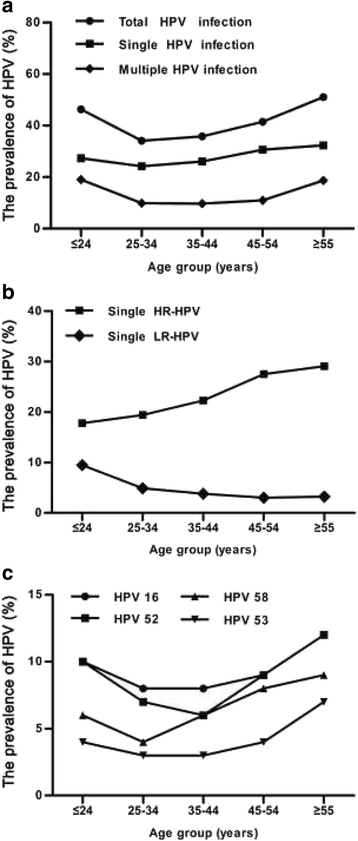Epidemiology of Humanpapilloma virus infection among women in Fujian, China
- PMID: 28774274
- PMCID: PMC5543557
- DOI: 10.1186/s12889-017-4651-7
Epidemiology of Humanpapilloma virus infection among women in Fujian, China
Erratum in
-
Erratum to: BMC Public Health, Vol. 18.BMC Public Health. 2017 Sep 22;17(1):736. doi: 10.1186/s12889-017-4709-6. BMC Public Health. 2017. PMID: 28938882 Free PMC article. No abstract available.
Abstract
Background: Human papillomavirus (HPV) infection is the main etiological factor for the development of cervical cancer. Here we assessed the prevalence and distribution of HPV genotypes in Fujian population.
Methods: A total of 8678 women aging from 17 to 84 years olds were recruited from the Fujian Medical University Union Hospital in Fujian Province. Every woman had a face-to-face interview. Cervical samples were collected from each participant and HPV screening was conducted using microarray hybridization.
Results: Our study showed that the HPV prevalence in Fujian province was 38.3%. Among the positive individuals, 70.6% were detected for single HPV infection, 29.4% for multiple HPV infections. Further analysis showed that the prevalence of HPV infection significantly increased from 2009 to 2015. The four most common high risk human papillomavirus (HR-HPV) genotypes were HPV16 (8.5%), HPV52 (7.9%), HPV58 (6.2%), HPV 53 (3.5%), collectively accounting for 60.5% of all detected HPV infection. Age subgroup analysis showed two peaks for the frequencies of overall and multiple HPV infections, one for the group of women under 25 years old, and the other for the group over 55 years old.
Conclusions: HPV infection is becoming serious in Fujian province, which indicates the imperative to implement a HPV vaccination and screening program for this region.
Keywords: Cervical cancer; Fujian; Genotyping; Human papillomavirus (HPV); Prevalence.
Conflict of interest statement
Ethics approval and consent to participate
These studies were performed in accordance with ethical guidelines under the protocols approved by the Institutional Medical Ethics Review Board of Affiliated Union Hospital of Fujian Medical University, Fuzhou, China. All adults who participated in the study signed a consent form.
Consent for publication
Not applicable.
Competing interests
The authors declare that they have no competing interests.
Publisher’s Note
Springer Nature remains neutral with regard to jurisdictional claims in published maps and institutional affiliations.
Figures


References
-
- Walboomers JM, Jacobs MV, Manos MM, Bosch FX, Kummer JA, Shah KV, Snijders PJ, Peto J, Meijer CJ, Munoz N. Human papillomavirus is a necessary cause of invasive cervical cancer worldwide. J Pathol. 1999;189(1):12–19. doi: 10.1002/(SICI)1096-9896(199909)189:1<12::AID-PATH431>3.0.CO;2-F. - DOI - PubMed
MeSH terms
LinkOut - more resources
Full Text Sources
Other Literature Sources

